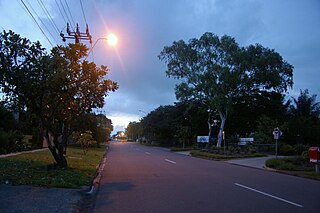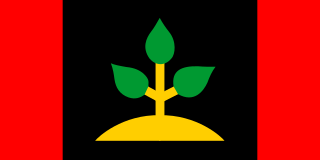
Darwin is the capital city of the Northern Territory, Australia. With a population of 139,902 at the 2021 census, the city contains most of the sparsely populated Northern Territory's residents. It is the smallest, wettest, and most northerly of the Australian capital cities and serves as the Top End's regional centre.

The Northern Territory is an Australian territory in the central and central northern regions of Australia. The Northern Territory shares its borders with Western Australia to the west, South Australia to the south, and Queensland to the east. To the north, the territory looks out to the Timor Sea, the Arafura Sea and the Gulf of Carpentaria, including Western New Guinea and other islands of the Indonesian archipelago.
Wadeye is a town in Australia's Northern Territory (NT). It was formerly known as Port Keats, a name originating from Port Keats Mission, which operated from 1935 until 1978. In last few years, Port Keats was run as an Aboriginal reserve by the Northern Territory Government, before being renamed Wadeye when control was passed to the Kardu Numida Council.

Crime in the Northern Territory is managed by the Northern Territory Police, the territory government's Department of the Attorney-General and Justice and Territory Families.

Larrakeyah is an inner suburb of Darwin, the capital city of Australia's Northern Territory. It was one of the first parts of the city to be developed, and borders the Darwin Central Business District. At the 2016 Census, there were 3,729 people in Larrakeyah. 54.9% of people were born in Australia. The next most common countries of birth were England 4.3%, Philippines 4.0% and New Zealand 2.7%. 66.0% of people spoke only English at home. The most common responses for religion were No Religion 31.8% and Catholic 23.5%. The suburb is located within the federal electorate of Solomon and the territory electorate of Port Darwin.

The Larrakia people are a group of Aboriginal Australian people in and around Darwin in the Northern Territory. The Larrakia, who refer to themselves as "Saltwater People", had a vibrant traditional society based on a close relationship with the sea and trade with neighbouring groups such as the Tiwi, Wadjiginy and Djerimanga. These groups shared ceremonies and songlines, and intermarried.

Tiwi is a northern suburb of the city of Darwin, Northern Territory, Australia. The suburb is bounded by Trower Road, Henbury Avenue and a coastal strip, separating Casuarina Beach and Lee Point Beach. It is in the Local Government Area of City of Darwin. It is home to Dripstone Middle School.
First Nations Radio, formerly, Radio Larrakia, is an Aboriginal Australian community radio station in Darwin, Northern Territory with a broadcast range that reaches Jabiru.

Alawa is a northern suburb of the city of Darwin, Northern Territory, Australia. It is bounded by Trower and Dripstone Roads, Lakeside Drive and the Rapid Creek in the local government area of City of Darwin.

Berrimah is an eastern suburb in the city of Darwin, in the Northern Territory of Australia.

Ludmilla is a northern inner suburb of the city of Darwin, Northern Territory, Australia. Ludmilla is a predominantly residential suburb and is usually associated with the adjacent inner Darwin suburbs of Parap, Fannie Bay and Stuart Park. The indigenous community of Bagot is located in Ludmilla.

The Hundred of Bagot is the cadastral unit of hundred for the city of Darwin, Northern Territory and the city of Palmerston. It includes the Local Government Areas of the City of Darwin, the northern part of the City of Palmerston and part of the north-western edge of the Shire of Litchfield.

Library & Archives NT comprises the Northern Territory Library and the two Northern Territory Archives Centres in Darwin and Alice Springs. Located in Parliament House in Darwin City, it is the premier public research and archival organisation focused on the history, development and culture of the Northern Territory of Australia. The library holds more than 108,000 books and 30,000 items. The archive holds Northern Territory Government records, which are normally opened 30 years after they were created.

Kahlin Compound was an institution for part-Aboriginal people in Darwin in the Northern Territory of Australia between 1913 and 1939. After 1924, "half-caste" children were separated from their parents and other adults and moved to an institution at Myilly Point.

The Retta Dixon Home was an institution for Aboriginal children in Darwin, Northern Territory, Australia, from 1946 until 1982. It was located on the Bagot Aboriginal Reserve, and run by Aborigines Inland Mission of Australia.
Lameroo Beach is a small beach located off the esplanade in central Darwin in the Northern Territory of Australia. It was the location of the town's historic baths between 1922 and 1974. The name for Lameroo Beach comes from a corrupted interpretation of the nearby Aboriginal site Damoe-Ra, which means "eye" or "spring" in Larrakia.
Kathleen Mary Mills, also known as Mooradoop and Aunty Kathy, was an Australian community leader, singer, Aboriginal elder and activist. She had a large family, all musical, with several of her daughters being well known as the Mills Sisters.
Poinciana Woman is the subject of an Australian urban legend that dates to the 1950s. There are multiple versions to the myth, but most follow the story of a woman who was raped and hanged, under a Poinciana tree, by a group of men in the East Point Reserve of Darwin, Northern Territory. It is said she haunts the area which has brought the attention of many news and media outlets such as the ABC and NITV.
The COVID-19 pandemic in the Northern Territory is part of the ongoing worldwide pandemic of the coronavirus disease 2019 caused by severe acute respiratory syndrome coronavirus 2.

The Darwin Hospital was a former hospital that was located at Myilly Point in Larrakeyah, an inner suburb of Darwin, Northern Territory in Australia. It was the second public hospital to be built in the city, replacing a facility that had originally opened in 1874 nearby on Packard Street, Larrakeyah. The hospital had a short but eventful history, being extensively damaged by air-raids during World War II and by Cyclone Tracy in 1974. For most of its operating life, the hospital maintained segregated wards for Aboriginal patients, a policy that did not extend to those of mixed race or Asian descent. It was replaced by Royal Darwin Hospital in the early 1980s.

















